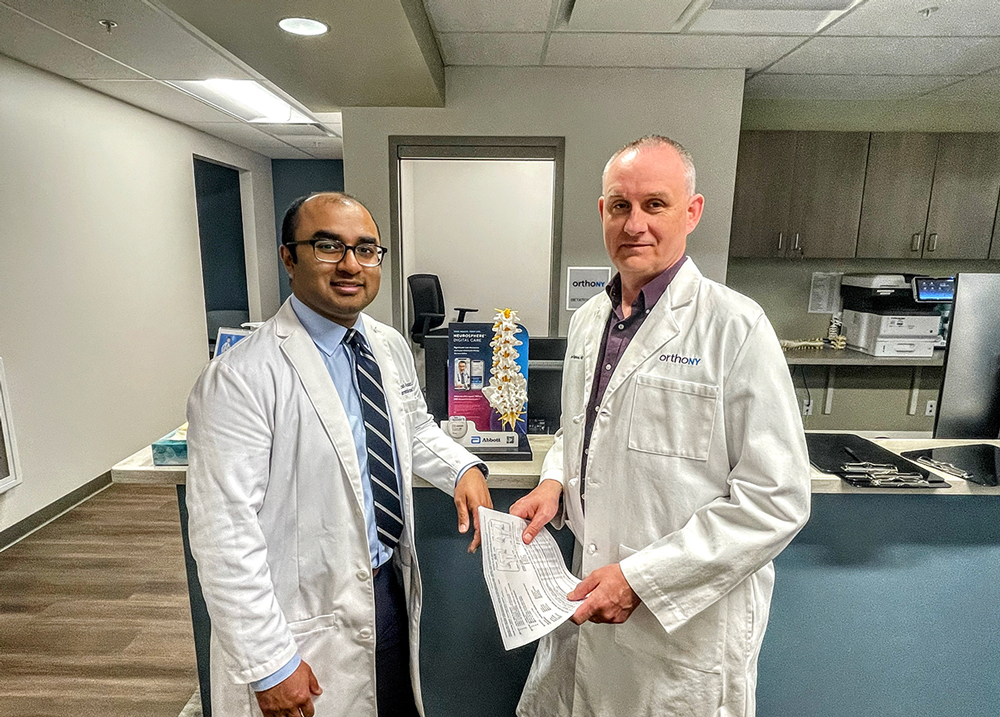
Saratoga Business Journal
By Christine Graf
During the past decade, the number of board-certified physician assistants (PAs) has increased more than 75 percent, with more than 168,000 currently practicing in the field. Each year, PAs are responsible for more than 500 million patient interactions, collaborating with physicians and surgeons to diagnose and treat patients.
The U.S. Bureau of Labor Statistics projects that the PA profession will increase 28 percent from 2021 to 2031. Currently, the demand for PAs is so high that 75 percent of graduates receive multiple job offers upon graduation.
In the late 1960s, Duke University established the country’s first physician assistant program. There are now 245 accredited programs in the United States, one of them at Albany Medical College where 42 PAs graduate each year from the 28-month program. Established in 1972, Albany Med’s PA program began as a collaboration with Hudson Valley Community College.
OrthoNY physician assistant James McGork III graduated from the Albany Med/Hudson Valley program, receiving his degree in 1998. A 1990 graduate of Mount Saint Mary’s College, he worked for Marriott Management Services before transitioning to health care.
It was while volunteering with the Moyers Corner Fire Department in Liverpool that he began considering a career change. After several years of volunteering as a medic on the rescue squad, he enrolled in the Albany Medical Center/Hudson Valley PA program. Upon graduating, he accepted a job at Albany Med, working in internal medicine, pediatrics, and urgent care.
From there, McGork ventured into orthopedics, working at North Country Sports Medicine in Queensbury. Later in his career, he worked in the orthopedics department at North Country Hospital in Vermont and as a surgical PA at Glens Falls Hospital. Today, McGork can be found treating patients at the OrthoNY Urgent Care in Clifton Park.
“As a PA, I am responsible for seeing and evaluating a patient, developing a treatment plan, and implementing that plan,” he said. “PAs are not independent practitioners, and we have a supervising physician. But that supervising physician does not have to be present.”
Although McGork has just one supervising physician, he collaborates with multiple physicians at OrthoNY, an orthopedic practice with eight offices located throughout the Capital Region.
“Each physician you work with has their own experiences and their own training, so the more people that you work with, the more knowledge you obtain,” he said. “In my opinion, I think that some PAs are in jobs where they are left on an island. By that, I mean that they may not have the physician support that they need.”
When starting their careers, it is not uncommon for PAs to find themselves with far more responsibility than they anticipated.
“I still remember my first day in the urgent care at Albany Med,” said McGork. “My supervising physician told me he was leaving, and I still had another three hours to work.”
Aware that many young PAs have similar experiences, McGork offers valuable advice when precepting students from the Albany Medical Center PA program.
“One of things that I tell them is, ‘When you are interviewing you are not only interviewing for the job. You should be interviewing them as a potential employer—understanding what they expect of you. You should also tell them what you expect of them.’”
McGork said he has been fortunate, receiving a tremendous amount of support and training throughout his entire career.
“Each physician has different expectations for the PA they supervise, and when I started in orthopedics at North Country Sports Medicine, I was expected to do far more than some of my colleagues. At times, it was very stressful, but in the long run, it has allowed me to do what I do today. It prepared me to be independent and to become a critical thinker,” he said.
In his opinion, it takes four or five years for a PA to feel comfortable with the job. Those who don’t receive enough support from their supervising physicians during that time may feel overwhelmed.
“It’s very stressful because they feel as though they have been left alone,” he said, noting that this is something he has never experienced personally.
In recent years, McGork said providers have been required to adapt to a medical system that is driven by insurance and ever-changing government mandates. This has, at times, challenged medical decision making. As a result, procedures, tests and exams have sometimes been denied and sometimes been required in order to proceed with treatment regardless of their necessity.
During his time in the urgent care, McGork has also noticed that a surprising number of people are complacent about their health, relying on urgent care to treat chronic conditions.
“Urgent cares are booming because people are using them for convenience. A lot of people come in with chronic conditions that they have not managed, and many of them do not have primary care providers. There is a significant shortage of primary care providers,” he said. “I have a lot of conversations with patients, explaining to them that going to urgent care for the third or fourth time for a chronic condition is not good management of their health care.”
Despite the challenges, McGork derives a great deal of satisfaction from working as a PA.
“If you are the type of person that likes to help people, it’s a great profession to be in. It’s very rewarding,” he said. “And as much as people complain about our healthcare system, I believe it is better than anywhere else in the world.”
